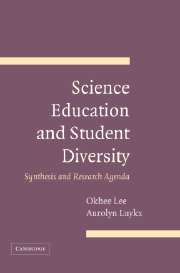Book contents
- Frontmatter
- Contents
- Foreword by Roland G. Tharp
- Acknowledgments
- Introduction
- SECTION I CONCEPTUAL GROUNDING AND POLICY CONTEXT
- SECTION II STUDENT LEARNING AND CLASSROOM PRACTICES
- SECTION III CREATING EQUITABLE LEARNING ENVIRONMENTS
- 7 Teacher Education
- 8 School Organization and Educational Policies
- 9 School and Home/Community Connections
- SECTION IV CONCLUSIONS AND A RESEARCH AGENDA
- Appendix: Method for Research Synthesis
- References
- Index
9 - School and Home/Community Connections
Published online by Cambridge University Press: 04 December 2009
- Frontmatter
- Contents
- Foreword by Roland G. Tharp
- Acknowledgments
- Introduction
- SECTION I CONCEPTUAL GROUNDING AND POLICY CONTEXT
- SECTION II STUDENT LEARNING AND CLASSROOM PRACTICES
- SECTION III CREATING EQUITABLE LEARNING ENVIRONMENTS
- 7 Teacher Education
- 8 School Organization and Educational Policies
- 9 School and Home/Community Connections
- SECTION IV CONCLUSIONS AND A RESEARCH AGENDA
- Appendix: Method for Research Synthesis
- References
- Index
Summary
Science achievement gaps among racial/ethnic and social class groups have been extensively documented, and several studies have examined the influences of families and home environments on students' science achievement. A challenge facing many schools is the lack of connection between schools and students' homes and communities. Students are more likely to disengage from schooling if they see it as irrelevant and meaningless to their lives beyond school. Yet students bring to the science classroom “funds of knowledge” from their communities that can serve as resources for academic learning, and academic learning is mediated by highly articulated tasks and activities that occur in the social contexts of day-to-day living, whether or not the school chooses to recognize this (Moll, 1992; Vélez-Ibáñez & Greenberg, 1992). The small number of studies on connections between science learning and students' families and communities can be grouped into three areas: (a) the influence of families and home environments on students' science learning, (b) school science and community connections, and (c) science learning among homeless children.
Families and Home Environments
There is clear evidence that family support influences children's achievement, attitudes, and aspirations, even after student ability and family SES are taken into account (Epstein, 1987; Oakes, 1990). R. A. Schibeci and J. P. Riley (1986) examined the influence of five background variables (i.e., race, gender, home environment [e.g., having an encyclopedia in one's home], amount of homework, and parents' education) on science achievement and attitudes.
- Type
- Chapter
- Information
- Science Education and Student DiversitySynthesis and Research Agenda, pp. 138 - 144Publisher: Cambridge University PressPrint publication year: 2006



